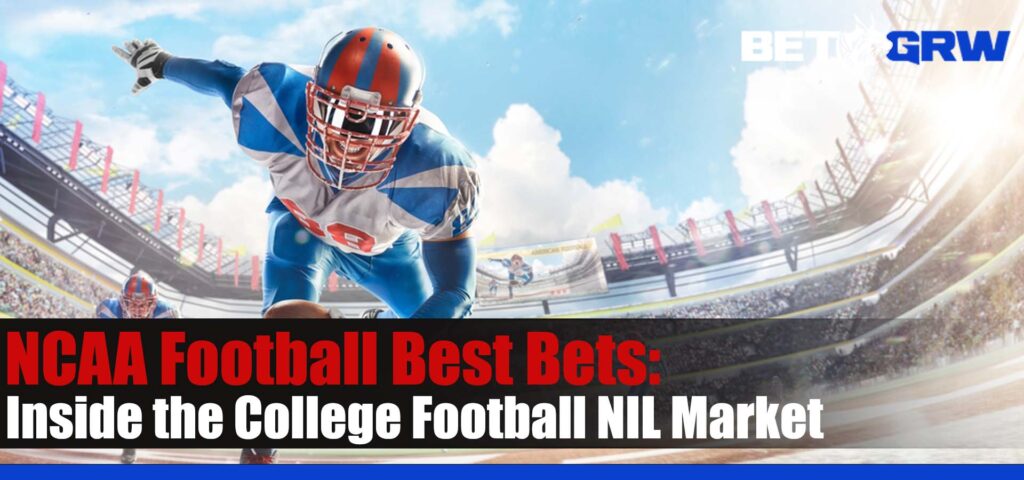
College Football NIL Market – The college football landscape has transformed dramatically with the advent of the Name, Image, and Likeness (NIL) agreements, reshaping not only the financial aspect of the sport but also the dynamics of player recruitment and retention. As we navigate through the third year of NIL operations, the complexity and opaqueness of these deals have become a notable point of discussion. With live betting in Canada and other regions gaining traction, understanding the economic incentives at play can provide insights into player performance and team strategies, which is crucial for making informed decisions in sports betting.
The NIL Economy: What Does It Cost to Secure a Starting Player?
The issue of what it takes to get a starting player in the currently existing college football environment is very complicated. Another difference is that salaries in professional sports are disclosed and uniform across the respective leagues whereas those related to NIL in college football are neither made public and nor there exists a single database for the information nor transparency of the deals and the layers of confidentiality. Opendorse provides some transparency, but much of this market is conducted “under the table.”.
CBS Sports has done fairly well in the sense of educating people on the NIL space by communicating with NIL agents, collections, team coaches, players, and their parents. The following figures indicate a range of what teams could possibly afford to attract and hold the talents that would otherwise move to the transfer portal.
The Quarterback Market: High Value, High Variability
The rate at which college football quarterbacks are being priced gives a clear picture that quarterbacks are gold in college football as it is in the NFL. Significantly, a starting quarterback in the Power Four conferences earns an average of $500,000-$800,000 a year. This valuation demonstrates the critical role that the quarterback plays in the dynamics of the game and why he is recognized as such a critical factor for the team.
However, not all institutions are up to these high expectations. For example, Auburn’s coach Hugh Freeze expressed the need to avoid spending $1 million on a transfer quarterback as some costly programs do. On the other side of the spectrum the elite quarterbacks have received contracts over $2 million dollars thus emphasizing the value of the position.
Running Backs and Wide Receivers: Balancing Cost and Talent
Running backs tend to come underpaid relative to quarterbacks as the former are paid between $200,000 and $300,000. This is typical for the football industry as the importance of the running back is somewhat reduced. Wide receivers, being players who have to be numerous in any given team because of the nature of their role, are paid a wide range of salaries ranging from $75,000 to $300,000. The variance is also the player’s skill and the strategic importance within teams they represent.
Linemen: The Unsung Heroes
The offensive and defensive linemen are some of the players that attract notable deals in the NIL market because they are significant in both the protection of the quarterback and disruption of the rival offense. Numbers of agreements that offensive linemen, especially left tackles, get offer NIL deals between $350,000 – $500,000. Defensive line players’ salaries come in a somewhat larger spectrum – the best ones wanting from $250 000 to $600 000, but some notable cases of exceptional performances in extremely valuable markets exceed these figures.
Defensive Backs and Linebackers: Strategic Investments
Defensive backs and linebackers are not nearly as valued as quarterbacks and linemen, but still are investments programs need to make if they want to build up their defense. Linebackers can get the highly lucrative contracts of up to $300,000 but mostly those who can become pass rushing specialists or play a significant role in defensive plan. Guys like cornerbacks and safeties who have the ability of changing the tide of the game get from $120,000 to $225,000 while the cream of the crop comes highest.
The Evolving College Football NIL Market Deals
As NIL deals continue to shape the landscape of college football, understanding the financial dynamics at play becomes crucial for stakeholders ranging from team management to bettors engaged in sports betting free picks. The market values assigned to these players not only reflect their on-field importance but also the strategic thinking of college programs aiming to optimize their rosters within the bounds of new financial realities. As we move forward, these NIL agreements will undoubtedly continue to influence the ebb and flow of college football, making every season a fascinating spectacle of sportsmanship and strategy.














